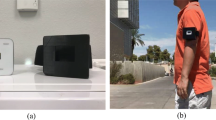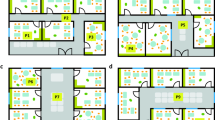Abstract
Libby, Montana is the only PM2.5 nonattainment area in the western United States with the exceptions of parts of southern California. During January through March 2005, a particulate matter (PM) sampling program was conducted within Libby’s elementary and middle schools to establish baseline indoor PM concentrations before a wood stove change-out program is implemented over the next several years. As part of this program, indoor concentrations of PM mass, organic carbon (OC), and elemental carbon (EC) in five different size fractions (>2.5, 1.0–2.5, 0.5–1.0, 0.25–0.5, and <0.25 μm) were measured. Total measured PM mass concentrations were much higher inside the elementary school, with particle size fraction (>2.5, 0.5–1.0, 0.25–0.5, and <0.25 μm) concentrations between 2 and 5 times higher when compared to the middle school. The 1.0–2.5 μm fraction had the largest difference between the two sites, with elementary school concentrations nearly 10 times higher than the middle school values. The carbon component for the schools’ indoor PM was found to be predominantly composed of OC. Measured total OC and EC concentrations, as well as concentrations within individual size fractions, were an average of two to five times higher at the elementary school when compared to the middle school. For the ultrafine fraction (<0.25), EC concentrations were similar between each of the schools. Despite the differences in concentrations between the schools at the various fraction levels, the OC/EC ratio was determined to be similar.
Similar content being viewed by others
References
Blondeau, P., Iordache, V., Poupard, O., Genin, D., & Allard, F. (2005). Relationship between outdoor and indoor air quality in eight French schools. Indoor Air, 15, 2–12.
Cavallo, D., Alcini, D., De Bortoli, M., Carrettoni, D., Carrer, P., Bersani, M., et al. (1993). Chemical contamination of indoor air in schools and office buildings in Milan, Italy. In: Proceedings of the 6th International Conference on Indoor Air Quality and Climate, Helsinki, Finland, Vol. 2, 45–50.
Chao, C. Y., & Wong, K. K. (2002). Residential indoor PM2.5 and PM10 in Hong Kong and the elemental composition. Atmospheric Environment, 36, 227–235.
Fischer, P. H., Hoek, G., van Reeuwijk, H., Briggs, D. J., Lebret, E., van Wijnen, J. H., et al. (2000). Traffic-related differences in outdoor and indoor concentrations of particles and volatile organic compounds in Amsterdam. Atmospheric Environment, 34, 3713–3722.
Fishbein, L., & Henry, C. J. (1991). Introduction: Workshop on the methodology for assessing health risks from complex mixtures in indoor air. Environmental Health Perspectives, 95, 3–5.
Geller, M. D., Chang, M., Sioutas, C., Ostro, B. D., & Lipsett, M. J. (2002). Indoor/outdoor relationship and chemical composition of fine and coarse particles in the southern California deserts. Atmospheric Environment, 36, 1099–1110.
Gotschi, T., Oglesby, L., Mathys, P., Monn, C., Manalis, N., Koistinen, K., et al. (2002). Comparison of black smoke and PM2.5 levels in indoor and outdoor environments of four European cities. Environmental Science & Technology, 36, 1191–1197.
He, C., Morawska, L., & Gilbert, D. (2005). Particle deposition rates in residential houses. Atmospheric Environment, 39, 3891–3899.
Hidy, G. M., Lachenmyer, C., Chow, J., & Watson, J. (2000). Urban outdoor–indoor PM2.5 and personal exposure in the deep south. Part II. Inorganic chemistry. Aerospace Science and Technology, 33, 357–375.
Janssen, N. A. H., Hoek, G., Brunekreef, B., Harssema, H., Mensink, I., & Zuidhof, A. (1998). Personal sampling of particles in adults: Relation among personal, indoor, and outdoor air concentrations. American Journal of Epidemiology, 147(6), 537–547.
Jenkins, P. L., Phillips, T. J., Mulberg, J. M., & Hui, S. P. (1992). Activity patterns of Californians: Use of and proximity to indoor pollutant sources. Atmospheric Research, 26A, 2141–2148.
Jones, N. C., Thornton, C. A., Mark, D., & Harrison, R. M. (2000). Indoor/outdoor relationships of particulate matter in domestic homes with roadside, urban, and rural locations. Atmospheric Environment, 34, 2603–2612.
Lachenmyer, C., & Hidy, G. M. (2000). Urban measurements of indoor–indoor PM2.5 concentrations in the deep south Part I. Pilot study of mass concentrations for nonsmoking subjects. Aerospace Science and Technology, 32, 34–51.
Lee, S. C., & Chang, M. (2000). Indoor and outdoor air quality investigation at schools in Hong Kong. Chemosphere, 41, 109–113.
Li, C. S., & Ro, Y. S. (2000). Indoor characteristics of polycyclic aromatic hydrocarbons in the urban atmosphere of Taipei. Atmospheric Environment, 34, 611–620.
Monn, C. (2001). Exposure assessment of air pollutants: A review on spatial heterogeneity and indoor/outdoor personal exposure to suspended particulate matter, nitrogen dioxide and ozone. Atmospheric Environment, 35, 1–32.
Oglesby, L., Kunzli, N., Roosli, M., Braun-Fahrlander, M., Mathys, P., Stern, W., et al. (2000). Validity of ambient levels of fine particles as surrogate for personal exposure to outdoor air pollution—results of the European Expolis-EAS study (Swiss Center Basel). Journal of the Air & Waste Management Association, 50, 1251–1261.
Rojas-Bracho, L., Suh, H. H., & Koutrakis, P. (2000). Relationship among personal, indoor and outdoor fine and coarse particle concentrations for individuals with COPD. Journal of Exposure Analysis and Environmental Epidemiology, 10(3), 294–306.
Simpson, C. D., Dills, R. L., Katz, B. S., & Kalman, D. A. (2004). Determination of levoglucosan in atmospheric fine particulate matter. Journal of the Air & Waste Management Association, 54, 689–694.
Wallace, L. (1996). Indoor particles: A review. Journal of the Air & Waste Management Association, 46, 98–126.
Wallace, L., & Williams, R. (2005). Use of personal-indoor–outdoor sulfur concentrations to estimate the infiltration factor and outdoor exposure factor for individual homes and persons. Environmental Science & Technology, 39, 1707–1714.
Ward, T. J., Rinehart, L. R., & Lange, T. (2006). The 2003/2004 Libby, Montana PM2.5 source apportionment research study. Aerospace Science and Technology, 40, 166–177.
Williams, R., Creason, J., Zweidinger, R., Watts, R., Sheldon, L., & Shy, C. (2000). Indoor, outdoor, and personal exposure monitoring of particulate air pollution: The Baltimore elderly epidemiology-exposure pilot study. Atmospheric Environment, 34, 4193–4204.
Yocom, J. E. (1982). Indoor–outdoor air quality relationships: a critical review. Journal of the Air Pollution Control Association, 32, 500–520.
Author information
Authors and Affiliations
Corresponding author
Rights and permissions
About this article
Cite this article
Ward, T.J., Noonan, C.W. & Hooper, K. Results of An Indoor Size Fractionated PM School Sampling Program in Libby, Montana. Environ Monit Assess 130, 163–171 (2007). https://doi.org/10.1007/s10661-006-9386-3
Received:
Accepted:
Published:
Issue Date:
DOI: https://doi.org/10.1007/s10661-006-9386-3




